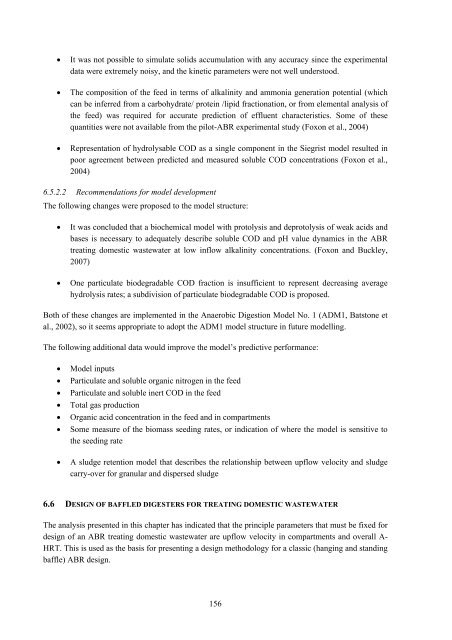analysis of a pilot-scale anaerobic baffled reactor treating domestic ...
analysis of a pilot-scale anaerobic baffled reactor treating domestic ...
analysis of a pilot-scale anaerobic baffled reactor treating domestic ...
You also want an ePaper? Increase the reach of your titles
YUMPU automatically turns print PDFs into web optimized ePapers that Google loves.
• It was not possible to simulate solids accumulation with any accuracy since the experimental<br />
data were extremely noisy, and the kinetic parameters were not well understood.<br />
• The composition <strong>of</strong> the feed in terms <strong>of</strong> alkalinity and ammonia generation potential (which<br />
can be inferred from a carbohydrate/ protein /lipid fractionation, or from elemental <strong>analysis</strong> <strong>of</strong><br />
the feed) was required for accurate prediction <strong>of</strong> effluent characteristics. Some <strong>of</strong> these<br />
quantities were not available from the <strong>pilot</strong>-ABR experimental study (Foxon et al., 2004)<br />
• Representation <strong>of</strong> hydrolysable COD as a single component in the Siegrist model resulted in<br />
poor agreement between predicted and measured soluble COD concentrations (Foxon et al.,<br />
2004)<br />
6.5.2.2 Recommendations for model development<br />
The following changes were proposed to the model structure:<br />
• It was concluded that a biochemical model with protolysis and deprotolysis <strong>of</strong> weak acids and<br />
bases is necessary to adequately describe soluble COD and pH value dynamics in the ABR<br />
<strong>treating</strong> <strong>domestic</strong> wastewater at low inflow alkalinity concentrations. (Foxon and Buckley,<br />
2007)<br />
• One particulate biodegradable COD fraction is insufficient to represent decreasing average<br />
hydrolysis rates; a subdivision <strong>of</strong> particulate biodegradable COD is proposed.<br />
Both <strong>of</strong> these changes are implemented in the Anaerobic Digestion Model No. 1 (ADM1, Batstone et<br />
al., 2002), so it seems appropriate to adopt the ADM1 model structure in future modelling.<br />
The following additional data would improve the model’s predictive performance:<br />
• Model inputs<br />
• Particulate and soluble organic nitrogen in the feed<br />
• Particulate and soluble inert COD in the feed<br />
• Total gas production<br />
• Organic acid concentration in the feed and in compartments<br />
• Some measure <strong>of</strong> the biomass seeding rates, or indication <strong>of</strong> where the model is sensitive to<br />
the seeding rate<br />
• A sludge retention model that describes the relationship between upflow velocity and sludge<br />
carry-over for granular and dispersed sludge<br />
6.6 DESIGN OF BAFFLED DIGESTERS FOR TREATING DOMESTIC WASTEWATER<br />
The <strong>analysis</strong> presented in this chapter has indicated that the principle parameters that must be fixed for<br />
design <strong>of</strong> an ABR <strong>treating</strong> <strong>domestic</strong> wastewater are upflow velocity in compartments and overall A-<br />
HRT. This is used as the basis for presenting a design methodology for a classic (hanging and standing<br />
baffle) ABR design.<br />
156
















